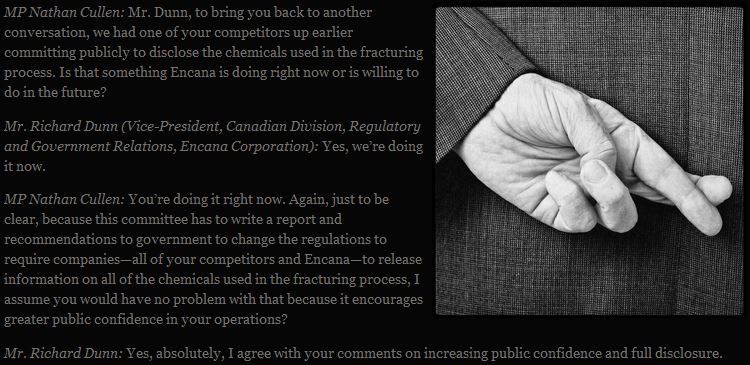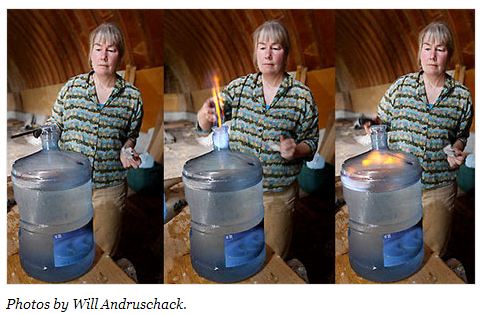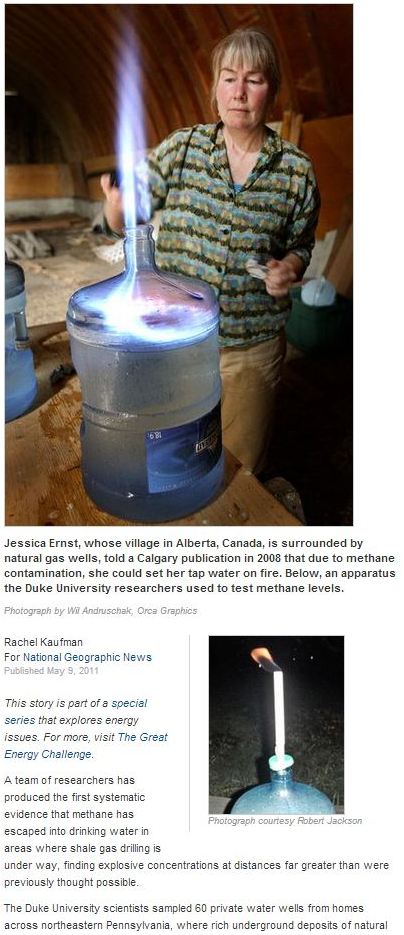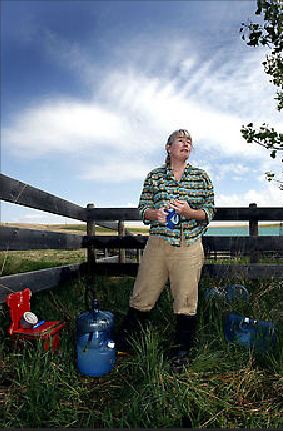Wyoming to test for same groundwater pollutants in Pavillion by Benjamin Storrow, June 12, 2014, Star-Tribune
State officials said Thursday that they intend to test the Pavillion area’s groundwater for nearly all the potential pollutants examined by the U.S. Environmental Protection Agency in its study of the region’s water supplies. That news drew criticism from some area landowners, who contend that their water was contaminated by a nearby natural gas field. They questioned state officials’ decision to leave one pollutant off the list because only EPA laboratories tested for the chemical, a glycol surfactant.
“Why did we spend a year and a half ripping EPA apart to say we don’t have EPA’s capability?” said John Fenton, chairman of the Pavillion Area Concerned Citizens Association. Testing procedure has long been at the center of the controversy over the source of groundwater contamination east of Pavillion. A preliminary investigation by the EPA concluded that the cause was natural gas operations from a nearby field. But the agency’s analysis was criticized for its procedure. Critics said water samples weren’t tested in a timely manner, as called for under the agency’s own guidelines, among other factors.
The EPA turned over its investigation into Pavillion to the state [and Encana] last year. The state investigation is divided into several parts. The Wyoming Oil and Gas Conservation Commission is studying the integrity of the natural gas wells and disposal pits where produced water is stored after production. The Wyoming Department of Environmental Quality is studying drinking water quality. [Want to bet they will say everything but fracing is to blame and let Encana entirely off the hook?]
Mark Thiesse, DEQ groundwater section manager, said there would be a “couple of minor differences” between the sampling done by DEQ and that done previously by EPA and the U.S. Geological Survey.
The state will also test for potential bacteria, pesticides and herbicides. [With which to blame the harmed families with as Encana, the regulators and Alberta Research Council (now Alberta Innovates-Technology Futures) did?] He noted that DEQ hired an independent third party to ensure all samples are treated in accordance with testing standards.
A long-standing criticism of the EPA study is that it did not account for the possibility of agricultural contamination. [How often do farmers use frac chemicals and massive teams of pumper trucks to inject toxic brews under high pressure into the ground?]
The reason the glycol surfactant was left off the list is that only EPA labs tested for it, Thiesse said. [So what? Let the state do the sampling, then send the samples sealed with witnesses if the EPA is so untrustworthy, and let the lab there do the analysis. Simple.] An EPA representative at the meeting later said the test had recently been approved for other labs.
“Everything we can think of we will look at,” Thiesse said. “We don’t have any focus, any preconceived views. [Want to make another bet the State is going to conclude what Encana told them to conclude, regardless of test results?] We’re taking a fresh look at this.”
None of the state’s studies is expected anytime soon. The oil and gas commission’s well integrity study is complete but is being reviewed by an independent expert.
The study will then be sent to Encana, the owner of the natural gas field in question, and the EPA for review before a draft is released to the public. [Emphasis added]
Groundwater Studies by rebecca, June 6, 2014, Riverton Radio
State officials say they’re finishing up two studies into the cause of groundwater pollution in a central Wyoming gas field. They plan to allow independent experts, the U.S. Environmental Protection Agency and gas field owner Encana to review the reports before publicly releasing them. Meanwhile, the Wyoming Department of Environmental Quality plans to resample groundwater and meet with residents of the Pavillion area next week. [Emphasis added]
Wyoming: Gas field pollution studies for Pavillion nearly done, Officials will meet with Pavillion residents on June 12 by Mead Gruver, June 6, 2014, Star-Tribune
State officials planning to meet with homeowners affected by tainted groundwater in a central Wyoming gas field said they have finished one investigation into possible causes of the pollution and are wrapping up another. No further details have been released regarding what might have been learned since the U.S. Environmental Protection Agency implicated hydraulic fracturing in a 2011 report.
State officials intend to allow independent experts to review and comment on the state reports, followed by the EPA and gas field owner Encana.
A Wyoming Oil and Gas Conservation Commission consultant will make any necessary changes [Like Dr. Alexander Blyth did on the Alberta water contamination reports after Encana frac’d the Rosebud drinking water aquifers?] before the reports are released to the public, said Jeremiah Rieman, energy policy adviser to Gov. Matt Mead.
“We don’t want to be in the position of providing draft conclusions that ultimately may change entirely based on other reviews that need to take place,” [eg. Keep Encana and the rest of the oil and gas industry happy?] Rieman said Wednesday. He said he would push for the reports to be released “sooner rather than later.”
On June 12, state officials plan to meet with residents near the tiny Fremont County community of Pavillion to discuss the studies and an ongoing program to supply affected homeowners with cisterns and trucked-in household water. [Where are Encana’s aquifer repair teams?]
“I hope they have some good, new information,” said Deb Thomas, of the group Pavillion Area Concerned Citizens. Some residents said their well water turned foul-smelling after gas development began to pick up in their area a decade ago.
In December 2011, the EPA announced it suspected that hydraulic fracturing had played a role in tainting the water. … The EPA never finalized the report or circulated it for peer review, however, and in June 2013, it handed over its investigation to Wyoming officials [funded by an Encana “donation”]. Now, three state studies of groundwater quality are each three to six months behind schedule.
The oil and gas commission has struggled to find suitable independent experts [that will agree to edit how Encana wants the reports?] to review the reports, while the commission has struggled with staffing issues, including a leadership change, Rieman said.
One of the state studies examined whether compromised gas well bores could have caused the problem. The state oil and gas commission forwarded a report on that investigation to an independent expert, David K. Dillon, of Centennial, Colorado, a couple of weeks ago. [Only one reviewer?]
Rieman said he intentionally hasn’t read the report before it is finalized and could not comment on any findings.
Commission officials plan to complete a report on a second study in a couple of weeks. The commission has not yet chosen an independent expert reviewer [also only one?] for that investigation into whether old waste pits could have leaked pollution, Rieman said.
The two reports initially were due to be completed in December 2013.
Meanwhile, a Wyoming Department of Environmental Quality contractor plans to resample Pavillion-area water wells next week for a third study. Officials expect that report, initially expected to be done this September, to be finished in December. [Emphasis added]
[Refer also to:
The secret editing of “independent expert” Alberta Research Council’s geochemist, Dr. Alex Blyth:
Justice Wittmann also questioned Ernst’s lawyer Murray Klippenstein about the government’s filing of a report by the Alberta Research Council that dismissed Ernst’s water well case as insignificant.
The government claimed the report was an independent review that proved there was no merit in the Ernst case.
Klippenstein argued that such a filing of evidence was inappropriate at this time.
He also submitted a collection of Alberta Environment emails obtained through freedom of information legislation that he argued show the Alberta Research Council report was edited by Alberta Environment and not an independent review.
Hi Alec, some more comments on the Ernst report, that for some reason I failed to include below:
Pg 19 – not sure Wikipedia is a valid reference source, though I’ve been out of the academic scene for awhile.
Pg 19 … can you finish the sentence off …
Pg 23 – state reasons why …
Pg 27/28 – Mention that …
Pg 28 … Elaborate on …
Pg 3/9 … use …
Pg 5 … Can you tack on …
Pg 6 … needs to be corrected
Pg 8 – clarify units …
Please leave the Kenny well out for now, as you’ll address it in other reports. Perhaps send me an updated draft before WE finalize.
Pg 5 3rd para – please reference …
Pg 8, 2nd para – a study of the potential for methane migration … is currently under investigation by AENV. WE plan to mention this study when WE roll out the complaint review findings, so perhaps WE should leave it out of this report.
Pg 11 … perhaps use …
Pg 31 … perhaps mention …
Also I attach a comment by Leslie Miller, which you may want to consider incorporating.
Hi Alec, just a couple of more comments on the Ernst report, please make the changes …
Hi Alec, Comments on the Signer report, please finalize and send report.
Pg 6 … please remove last sentence like before
Table 2 – please make sure …
Pg 14 … WE need to be prepared for the question …
Pg 32 – please expand …
Also, I like how you phrase things at the end of page 31 about propane/butane (last sentence) and wonder if you can use this wording in the Ernst report as well if it’s not too late.
Steve
Steve Wallace, M.Sc., P.Geol.
Hydrogeologist
Alberta Environment, Groundwater Policy Unit
10th fl Oxbridge Place, 9820 – 106 Street
Edmonton, Alberta T5K 2J6
Phone: (780) 427-9759 Fax: (780) 422-4192
Dr Alexander (Alec) Blyth now teaches at the University of Waterloo:
2014: An Alberta government lawyer argued in court this week that Jessica Ernst’s lawsuit on hydraulic fracturing and groundwater contamination should be struck down on the grounds that it would open a floodgate of litigation against the province.
“There could be millions or billions of dollars worth of damages,” argued Crown counsel Neil Boyle.
More on Encana at Pavillion and the frac contaminated groundwater there:
2013 Look Back: EPA abandons Pavillion investigation into fracking and groundwater contamination
Encana funded and Encana-enabling-State led Pavillion area groundwater investigation begins
Wyoming regulators OK Encana waste well into aquifer used for drinking
Fracking water at Pavillion again shows pollutants, EPA says
Wyoming Water Tests in Line With EPA Finding on Fracking
EPA: Pavillion, Wyo., Natural-Gas Site Tests ‘Consistent’ With Earlier Data
The Entire Oil And Gas Industry Is Watching A Tiny Town In Wyoming
USGS Fracking Study Confirms Methane Contamination of Drinking Water in Pavillion, Wyoming
EPA retesting finds fracking-related groundwater contamination at Wyoming site
Busted, Part Deux! Fracking Chemicals Found in Wyoming Water Supply
USGS Aquifer Tests Near Pavillion, Wyoming Reveal Petroleum-Based Pollutants In Samples
Diesel in Water Near Fracking Confirms EPA Tests Wyoming Disputes
Encana donates $60,000 to dorm upgrade at Wyoming State Fairgrounds
Pavillion cisterns a go, but aquifer repair teams nowhere to be see, not even from Encana
Few takers yet on cistern offer near Pavillion
Top Wyo Official says Pavillion fracking investigation motivated by greed
Wyoming official pins Pavillion pollution complaints on greed
In Land of Gas Drilling, Battle for Water That Doesn’t Reek or Fizz
State offers water cisterns to residents near Pavillion
Analysis Confirms That Hydraulic Fracturing Caused Drinking Water Contamination In Wyoming
Review blames Encana’s fracking for water contamination in Pavillion
Natural gas giant EnCana to submit own findings to U.S. environmental agency
Nature, not hydraulic fracturing, is to blame for smelly water in Pavilion, Wyoming, said Encana Corp. on Tuesday.…
On Tuesday afternoon the Washington, D.C. based environmental agency defended its findings, reiterating the chemicals found were common to hydraulic fracturing, were not naturally occurring, and had been used in the Pavillion field.
Fracking Contamination ‘Will Get Worse’: Alberta Expert Dr. Karlis Muehlenbachs
Earlier this month the U.S. Environmental Protection Agency found that EnCana, the continent’s second largest shale gas producer, had contaminated groundwater in Pavillion, Wyoming. Those findings, which contradict industry assurances, didn’t surprise Muehlenbachs, who has studied leaking wells in Alberta’s heavy oil fields for decades.…
“The way I read the EPA report, the surface casings were too short and that the cementing was inadequate and then they fracked at very shallow depths. It’s almost negligence,” says 67-year-old Muehlenbachs…. “They’ll frack each well up to 20 times.
Each time the pressure will shudder and bang the pipes in the wellbore. The cement is hard and the steel is soft. If you do it all the time you are going to break bonds and cause leaks. It’s a real major issue.”…
Whenever methane leaks from one well into a neighboring wellsite, “industry says let’s fix the leaks,” says Muehlenbachs. “But as soon as the leaks enter groundwater, everyone abandons the same logic and technology and says it can’t happen and the denials come out. In Alberta, it’s almost a religious belief that gas leaks can’t contaminate groundwater.”…
Asked if Alberta’s oil patch regulator or B.C.’s Oil and Gas Commission had approached one of the world’s leading experts on how to fingerprint leaking gases from gas formations, Muehlenbachs replied quickly. “No,” said Muehlenbachs. “No one pays any attention to me. The Alberta regulators are only interested in optimizing production.” [Emphasis added]
EPA says fracking likely polluted Wyoming aquifer
Feds Link Water Contamination to Fracking
Alleged gas-drilling contamination of Wyoming well water scraps EnCana sale
Buyer nixes deal for EnCana’s controversial Wyoming natural gas assets
November 13, 2011: Busted! Fracking Chemical Found in Wyoming Water Supply
Citizens Call for Investigation and Halt to Encana’s Proposed Sale of Pavillion Gas Field
Asked about possible sources of contaminants found by the EPA, Hock said some may have come from water well components such as rubber washers. Methane found in some wells — which prompted officials to recommend ventilating bathrooms when showering — was at “extremely low” levels, indicating that it was naturally occurring, he said. “If this was related to oil and gas production wells, we would be seeing much higher levels of methane,” Hock said. [Emphasis added]
[What does that Encana admission say about the extremely high and dangerous methane levels in Rosebud’s drinking water?]
September 1, 2010: Pavillion, Wyoming-area residents told not to drink water
EnCana Oil and Gas USA, which operates oil and gas wells interspersed throughout the farm and ranch community, has agreed to provide funding to a third party which will provide treatment or an alternate source of drinking water.
2011 Encana breaks promise to disclose frac chemicals used in Pavillion Wyoming:
2010 Encana in Canada promises they provide complete chemical disclosure: ‘Yes, We’re Doing It Now’ – Encana’s Testimony to a Parliamentary Committee Stating Their Cooperation in Publicly Disclosing All the Chemicals Used in Fracking :
August 25, 2009 USA EPA: Chemicals Found in Wyo. Drinking Water Might Be From Fracking
EPA investigators explained that because they had no idea what to test for, they were relegated to an exhaustive process of scanning water samples for spikes in unidentified compounds and then running those compounds like fingerprints through a criminal database for matches against a vast library of unregulated and understudied substances. That is how they found the adamantanes and 2-BE.
An EnCana representative told the crowd that the company was as concerned about the contamination as the residents were, and pledged to help the EPA in its investigation.
Some people seemed confounded by what they were hearing.
“How in god’s name can the oil industry dump sh*t in our drinking water and not tell us what it is?” shouted Alan Hofer, who lives near the center of the sites being investigated by the EPA.
“If they’d tell us what they were using then you could go out and test for things and it would make it a lot easier, right?” asked Jim Van Dorn, who represents Wyoming Rural Water, a nonprofit that advises utilities and private well owners on water management.
“Exactly,” said Luke Chavez, the EPA’s chief Superfund investigator on the project. “That’s our idea too.”
Now that the EPA has found a chemical used in fracturing fluids in Pavillion’s drinking water, Chavez said the next step in the research is to ask EnCana for a list of the chemicals it uses and then do more sampling using that list. (An EnCana spokesman told ProPublica the company will supply any information that the EPA requires.) [Emphasis added]
Ernst’s contaminated water at Rosebud
Photos from Calgary Fast Forward’s Encana slide show
January 1, 2008: Encana Passes the Buck on Contamination in Pavillion, Wyoming






